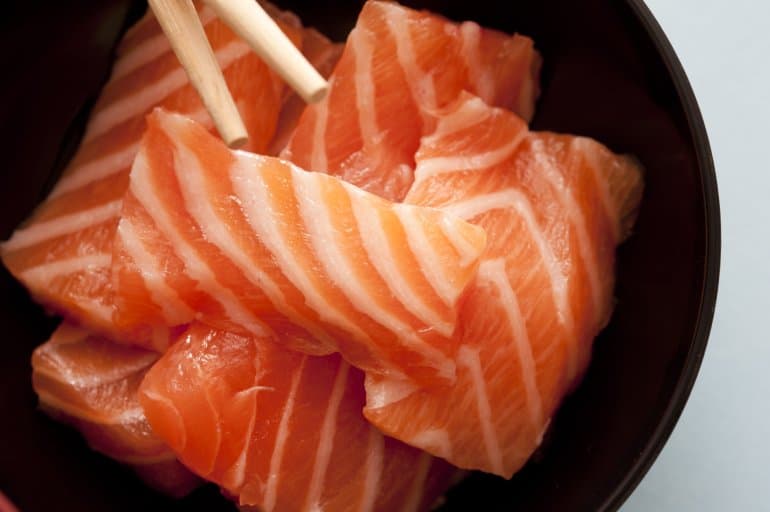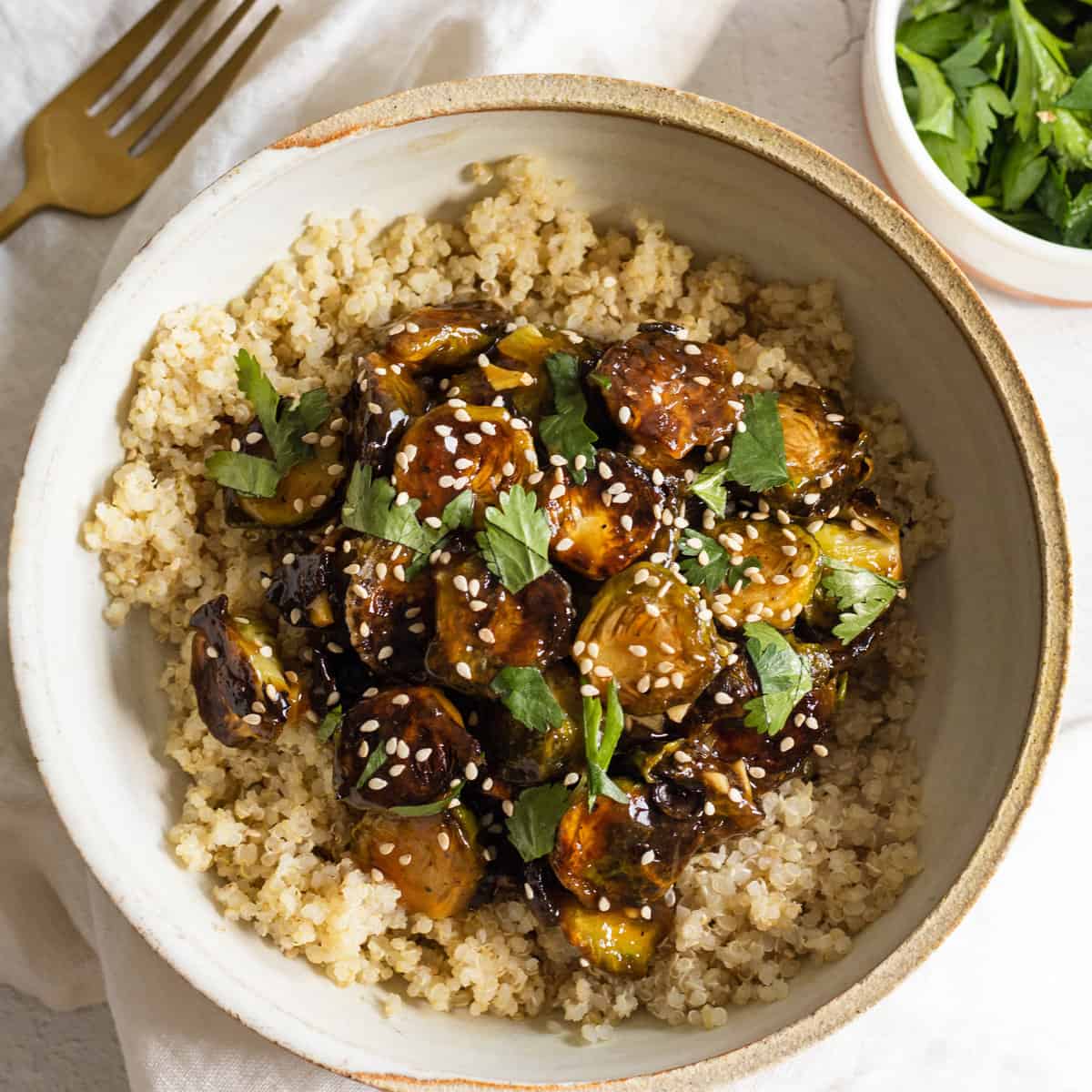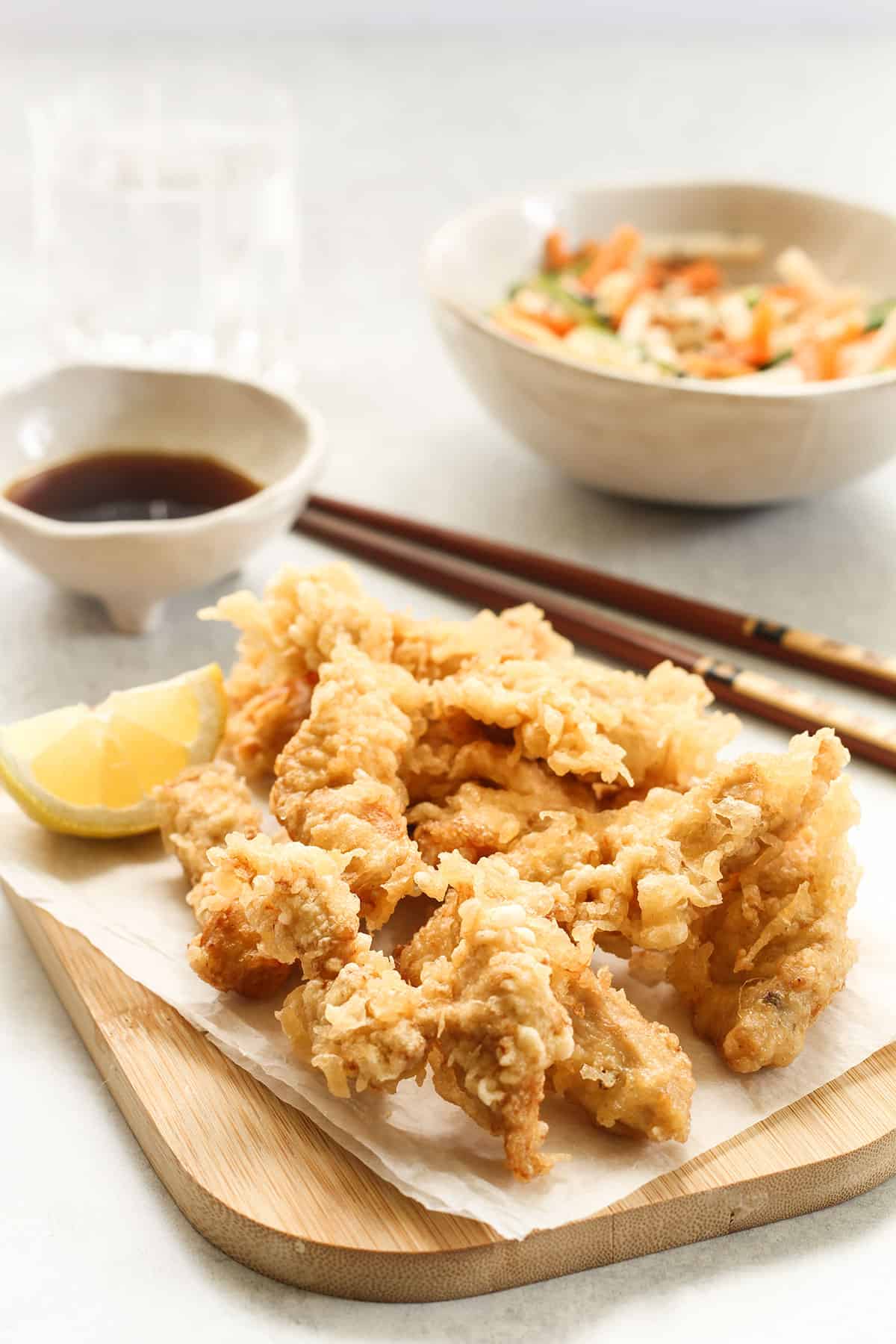Sashimi is a traditional Japanese dish that is beautiful in its simplicity. But it is so simple that it does not stand alone as a complete meal! If you are looking for sides to add to this dish, you have come to the right place. Here you will find 35 sides to serve with sashimi–or any other Japanese cuisine that you love.

Sashimi is very simply delicious. It’s simple because there is only one ingredient: high-quality, sushi-grade fish.
Sashimi is different from sushi because while it is made with raw fish, that’s all there is to sashimi. It is thinly sliced, bite-sized pieces of fish.
This simplicity makes for a delicious main dish, as each bite is filled with natural flavor. But for many people, the simplicity of sashimi is just too simple. Many people crave more to their meal than simply fish.
Luckily, the simplicity of the dish also means it can be dressed up or down and paired with many different side dishes that complement the meal perfectly.
If you are planning to serve sashimi at your next gathering, here are 35 sides you can add to the table.
FAQs

The quick answer is yes, sashimi is totally raw. It is also very, very fresh. The only fish that is safe to serve as sashimi is the highest-quality fresh sushi-grade fish. Salmon and tuna are the most common, but you can find many different kinds of freshwater fish served as sashimi.
Sashimi may be paired with daikon radish, wasabi or ginger which may be pickled or fresh.
Many people are hesitant to eat sashimi because it is made with raw ingredients. This simple fact makes people even more afraid to attempt to make it in their own homes.
Raw food does need to be stored properly to prevent any bacteria from developing, but in general sashimi is safe to keep in the refrigerator for a day or two. Be aware that it may develop a more fishy flavor the longer it sits, so it’s best to enjoy it right away.
Only sushi-grade fish is safe for sashimi. Do not use any seafood that is not clearly labeled as sushi grade.
The difference between sashimi and sushi is all in the rice. Sashimi is a very simple cut of fish, but sushi is cuts of fish on top of rice. Often sushi also contains other vegetables and sauces.
Both of these dishes can be part of a healthy diet. Fish is full of omega-3 fatty acids, protein, and is low in calories. Both are usually paired with vegetables in some form.
Visit this article for more information on the Differences between Sushi and Sashimi.
The fish in sashimi is very specifically sourced to be eaten fully raw. It is usually only made with saltwater fish, as these are less likely to carry harmful bacteria. It is also caught and processed quickly to ensure the sushi-grade fish you find at the store is as fresh as possible.
If you have never tried sushi before, sashimi may be a great place to start for the first time. Sashimi is made only with raw fish, and no other ingredients. Singling the fish out can help you determine which delicate flavors you do and don’t like–before they are placed in a roll and mixed with competing flavors.
If you are unsure if raw fish is your thing, start slow. Prepare your palate by trying some fish-free sushi rolls like a cucumber roll or California roll (usually made with real or imitation crab meat), to see how you like it.
Sashimi and raw fish in general have a unique texture that may be an acquired taste. If textures do not bother you, jump right in! The fresh flavor is excellent.
While sushi is full of inexpensive ingredients like rice and vegetables, sashimi is straight fish, which makes it more expensive at most restaurants. It is a Japanese delicacy. The good news is high-quality fish is full of protein which makes you feel full faster so you may find you eat much less sashimi than sushi.
Sushi Rice is what makes sushi. It is rice that has been flavored with a combination of rice vinegar and sugar. This combination makes the rice sticky and also a bit tangy. It makes the rice perfect for rolling into bite-sized pieces and also provides a delicious burst of flavor to the roll.
To serve sashimi, use a very sharp knife and slice the fish into thin slices and then small rectangles, about ¼ inch thick and an inch long. Place the thin strips on a bed of daikon radish or another garnish and serve with a small amount of wasabi and ginger.
Favorite Recipes
- Tuna Sashimi from the Spruce Eats is a great place to start making sashimi at home.
- Salmon Sashimi from Aubrey’s Kitchen is another great recipe for a beginner.
Expert Tips

- If you are going to make your sashimi at home, it is vital to purchase the appropriate fish. Not just any fish will do for sashimi, even if you get the butcher’s guarantee that it is fresh and delicious. You can often purchase sushi-grade fresh fish from a sushi restaurant. You may also find it at more high-end grocery stores, especially those with a sushi section.
- If you are having trouble cutting your fish, place it in the freezer for about ten minutes, and then try again. This will help the meat solidify a bit which makes it much easier to slice.
- Wipe your knife between cuts to make the knife slide easier.
- Sashimi should be served right away for the best flavor. This is not a meal you should try to prepare ahead.
What to Serve With Sashimi
- Garnishes: Microgreens, daikon radish, lemon, pickled ginger, tobiko, chives, sesame seeds, panko bread crumbs, green onions, sesame oil
- Dipping Sauce: Soy sauce, sriracha, ponzu sauce, yum yum sauce, eel sauce, horseradish, boom boom sauce, teriyaki sauce
- Sides: Fried rice, ramen, miso soup, steamed cabbage, seaweed salad, kani salad, gyoza dumplings, cucumber sesame salad, Japanese potato salad, shrimp tempura, warm mushroom salad, shiitake mushrooms, fresh vegetables
- Desserts: Matcha ice cream, mango slices, dango
- Drinks: Green tea
Recipes to Serve with Sashimi
Homemade Yum Yum Sauce

Japanese Ginger Sauce

Instant Pot Chicken Fried Rice

How To Make Sushi Rice without a Rice Cooker

Korean Cucumber Salad

Japanese Milk Tea Recipe

Beef Yakisoba Recipe

Chicken Katsu Curry Recipe

Chicken Katsudon Recipe

Crispy General Tso’s Brussels Sprouts

A big factor in liking and enjoying vegetables is preparing them properly. Take brussels sprouts for example. Prepared badly (like boiling) they taste horrible. But if you get them nice and crispy they are delicious. These crispy general tso’s brussels sprouts are a perfect recipe to convert over a veggie hater.
Easy Spicy Cucumber Salad with Peanuts

This Spicy Cucumber Salad Recipe is a healthy and refreshing side dish. Add some canned tuna, cooked shredded chicken, or leftover baked salmon, and it becomes the perfect light summer meal. It’s ready in 15 minutes, infused with a spicy homemade dressing, and topped with crunchy peanuts.
Chinese Egg Rolls Recipe

Spicy Garlic Edamame

Spicy Garlic Edamame is an easy and delicious snack or appetizer. Just four ingredients and 10 minutes is all it takes to make this spicy edamame recipes that you’ll find yourself craving again and again.
Japanese Yamagobo

This recipe for Yamagobo is natural, quick as heck to make, doesn’t require any hard-to-find ingredients, and is so easy you can do it blindfolded.
Mango and Avocado Salad

This beautiful chopped mango avocado salad recipe is healthy, incredibly satisfying, and ready in 15 minutes. It’s a quick lunch option or sub in whatever mix of proteins you have on hand, and voila, dinner is served!
Miso Mushrooms

Miso mushrooms are one of the most delicious, comforting, super easy side dishes you can make! Mushrooms are sautéed to golden perfection and then are generously coated in a rich, garlicky miso butter. They can be enjoyed as part of a meal or are a great appetizer too. In just 25 minutes, you’ll have the best mushrooms packed with irresistible umami flavor!
Shichimi Togarashi Spiced Roasted Potatoes

Shichimi tōgarashi (七味唐辛子) is a blend of seven or more spices popular in Japanese cooking. It’s quickly become one of my favourite spice discoveries and I’m constantly experimenting with adding it to different recipes, which is how these Shichimi Togarashi Seasoned Potatoes were born!
Spicy Mango Kani Salad

Mango kani salad is that addictive “crab” salad you get at Japanese restaurants. Both sweet and salty, you may have had it as a side salad or in spicy crab rolls.
Teriyaki Tofu

Teriyaki Tofu with a crisp coating but wobbly, oozy center- the trick is to use the right type of tofu- coated in a deliciously savory teriyaki sauce. (I have shown you how to make your own teriyaki sauce, but you can also use shop-bought.)
Gyoza

How to make the best Gyoza, or Japanese Pan-Fried Potstickers, from scratch like a pro! Juicy, tender, flavorful pork wrapped in pasta-like gyoza wrappers and pan-fried until golden brown and crispy on the outside. Easy to make, enjoy these delightful little pork dumplings as a light dinner or delicious appetizer with homemade gyoza dipping sauce.
Hiyayakko

Hiyayakko (冷奴) is a Japanese silken tofu appetizer, served chilled and seasoned with a smattering of savoury toppings, like soy sauce, scallions, and ginger. This recipe has a centuries-long history in Japan, dating back to the Edo period in the 1600’s. With endless flavour variations, it’s the ultimate lazy snack.
Miso Eggplant

This miso eggplant is ridiculously good and only takes a couple of ingredients. It’s a super quick side dish for any occasion, and the miso glaze is both ultra-delicious and unique. Miso, rice vinegar, crushed red pepper, and brown sugar are combined for a four-ingredient glaze that comes together in a flash. This recipe is quite simply absolutely amazing!
Chicken Tempura

Tender juicy chicken pieces coated in a super light and crispy batter. Discover the secrets to creating the ultimate homemade Chicken Tempura with this easy-to-follow recipe.
Korean Broccoli Salad

This vegan Korean Broccoli Salad is an incredibly easy recipe that comes together in just 15 minutes. Tender-yet-crisp steamed broccoli is tossed in a savory and spicy sauce, then garnished with sesame seeds. Serve it as a vibrant side dish, healthy appetizer, or light snack.
Citrus Ponzu Sauce

A bright citrusy ponzu sauce to serve with your favorite hotpot dish, over your sashimi or as a nigiri dipping sauce.
Japanese Pickled Ginger for Sushi

Quick Japanese sliced pickled ginger to serve with your favorite homemade sushi! Making a jar of homemade ginger pickle (aka gari) has never been easier than that.
Oyako Donburi (Chicken and Egg Over Rice)

My recipe for oyako donburi is Japanese inspired comfort food: chicken that is tender to perfection, flavorful, with lots of yummy sauce over fresh hot steamy rice. You can prep this dish ahead of time and it is easy to make for busy weeknight dinners.
Purple Daikon Radish Recipe

Have you ever tasted purple daikon radish? You’ll be surprised by how delicious it is and how quickly this dish comes together. It only takes about 10 minutes from prep to table! The toasted black sesame seeds add a nutty flavor that perfectly compliments this daikon variety’s natural sweetness. The recipe below is vegan and provides step-by-step instructions with a video.
Easy Seaweed Salad

This Easy Seaweed Salad (Wakame) is a flavourful and delicious Japanese-style salad made with dried seaweed that has been reconstituted. It only takes a few minutes to make, and pairs well with Poke Bowls or enjoyed on its own.
Kabocha No Nimono

Kabocha is a bright, sweet squash and this classic Japanese way of preparing it, kabocha no nimono, really brings out the best in it. Tender, flavorful and with such a great rounded flavor. A delicious side.
Stir Fry Recipe

Looking for a 15-minute stir fry recipe? This keto vegan stir fry is made with colorful vegetables and simple spices. It’s a quick and easy dinner that is healthy and nutritious.
Goma Dressing

This simple, fast-to-make, plant-based sesame dressing is found all over Japanese restaurant menus as a house salad dressing. In Japanese the dressing is called ごまドレ (Go-mah-doe-ray). “Goma” means sesame and “Dore” is an abbreviation of Doresshingu (a Japanese word for dressing).
Cold Soba Noodle Salad

This Cold Soba Noodle Salad is my go-to whenever I am craving something light and refreshing for dinner. It’s ready in just 20 minutes or less! I love the nutty flavor and al dente texture of Japanese soba noodles, complemented with fresh crunchy vegetables and a delicious soy-honey dressing.





Leave a Reply